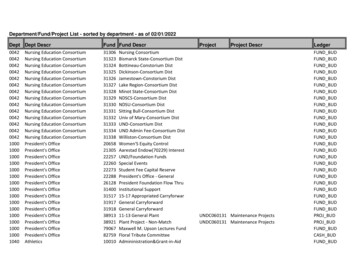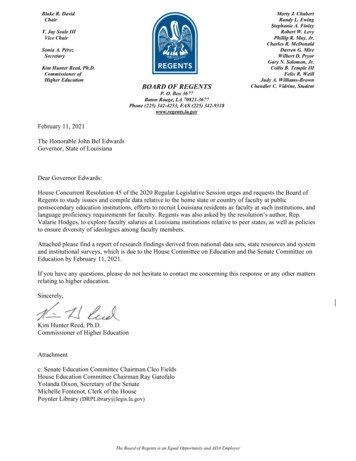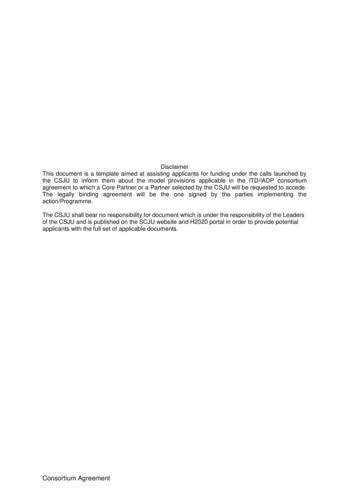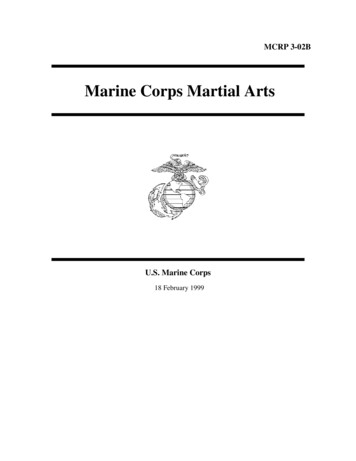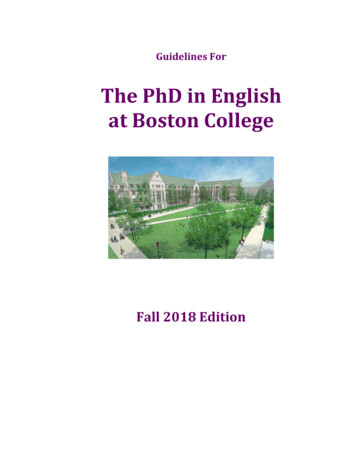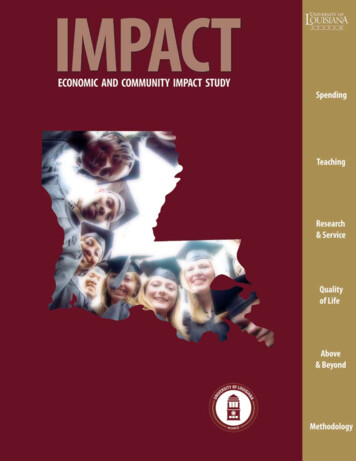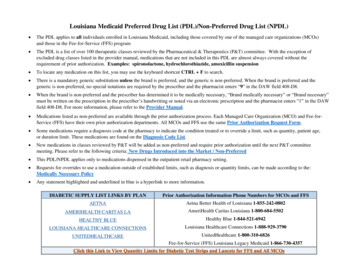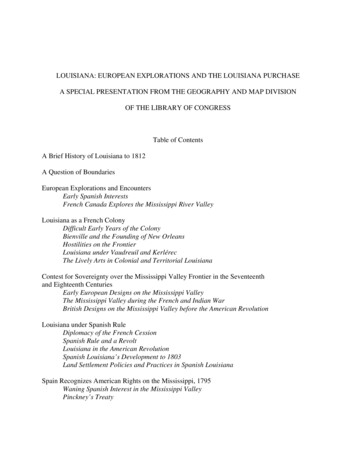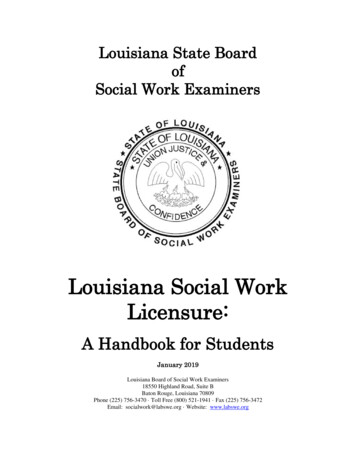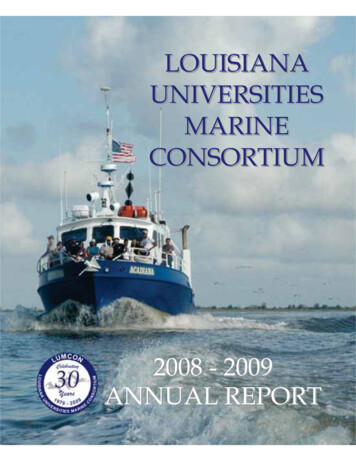
Transcription
LOUISIANAUNIVERSITIESMARINECONSORTIUM2008 - 2009ANNUAL REPORT1
Our Mission“To increase society’s awareness of the environmental, economic and cultural value of Louisiana’scoastal and marine environments by conducting research and education programs directly relevant toLouisiana’s needs in marine science and coastal resources and serving as a facility for all Louisianaschools with interests in marine research and education.”Message from the DirectorAs I worked with the LUMCON staff in the preparation of this report, I continued to reflect on LUMCON’s great performance in research and education in the past year, despite dwindling resources anda difficult 2008 hurricane season.Hurricanes Gustav and Ike ravaged the northwestern coastal Gulf of Mexico. The eye wall of Gustavcrossed the Cocodrie Marine Center with 157 mph wind gusts, and Ike brought the highest floodingand worst inundation of mud since the completion of the Marine Center in 1986. The Marine Centerwas closed from August 30 to September 24, 2008, because of lack of water and electricity. The hurricanes exacerbated facility damages from Hurricanes Katrina and Rita in 2005. As a result, many research projects suffered setbacks and required time to recuperate and rebuild, but the excellent workcontinues.LUMCON’s research projects continue to serve Louisiana in its need for science that supports soundresource decisions, such as those required for guiding coastal restoration. The research conducted atLUMCON serves the public in many areas, including human health, sustainable living resources, waterquality conditions, and ecosystem health.Much of the altered coastal landscape and changes in Louisiana’s coastal ecosystem derive directlyfrom human activities in the coastal zone or farther afield from the Mississippi River watershed. Lessdirect impacts result from human activities that lead to global climate change, including increasingtemperatures, changes in precipitation patterns, sea level rise and changes in intensity and severity ofNorth Atlantic Ocean tropical storms. Humans are part of the coastal ecosystem, depend on it, andmold it with their activities. Many of the LUMCON research programs described in this report developwithin the interaction of scientific curiosity, hypothesis testing, management needs and sound policydecisions. Our goal is to continue research programs that are directly relevant to Louisiana’s needs inmarine science and coastal resources.Our education programs complement our research (and vice versa), by providing the public withmeaningful and useful information concerning our coastal landscape and our interactions with it. LUMCON continues to serve higher education by offering formal university courses, with 37 students enrolled for 127 credits during the 2008-2009 Fiscal Year, and an additional 35 students participating inour faculty’s research programs. A total of 181 college students participatedin field trips (19 universities, 8 from Louisiana). K-12 education contacthours for field trips, outreach, Bayouside Classroom, and special activitiesapproached 18,500, with over 2000 students participating in field trips. Almost 700 teachers participated in LUMCON/BTNEP workshops.In reading the details of LUMCON’s Annual Report for Fiscal Year 20082009, I think you will agree that LUMCON remains a unique and remarkable asset for theState of Louisiana and its higher education imperative.2
The W. J. DeFelice Marine CenterSeptember 2008 — Hurricanes Gustav and Ike ravaged thenorthwest coastal Gulf of Mexico. The eye wall of Gustavcrossed Cocodrie with 157 mph wind gusts, and Ike broughtthe highest and most mud-laden flooding since the end ofMarine Center construction in 1986. The effects of the twostorms—wind and water, respectively—were similar to a singleHurricane Andrew in 1992. The Marine Center was closed fromAugust 30 to September 24 because of lack of water and electricity. The damages complicated and added to damages fromHurricanes Katrina and Rita in 2005.September 2008 — LUMCON added two new faculty members.Alexander Kolker from the Department of Earth and Environmental Sciences at Tulane University’sSchool of Science and Engineering brings his expertise in coastal sediment dynamics and wetlandprocesses. Geoff Sinclair from the Department of Marine, Earth and Atmospheric Sciences at NorthCarolina State University (NCSU) is a specialist in phytoplankton ecology.December 2008 — Water quality managers from several midwestern states and regional offices of theU.S. Environmental Protection Agency gathered in Cocodrie for a first-hand look at what causes thelow oxygen area in the Gulf of Mexico, commonly called the ‘Dead Zone.’January 2009 — LUMCON's Marine Center was home for Science ApplicationInternational Corporation (SAIC) work for NOAA with computerized surveydata for debris funded by FEMA. The three survey segments covered thearea from Caillou Bay to Belle Pass, Louisiana.February 2009—Volunteers from America's Wetland Conservation Corps, anAmeriCorp program, gathered at LUMCON for three days of training andthe opportunity to mingle with their counterparts from other areas of thestate. The workshop featured talks from professionals from state agencies,Louisiana Sea Grant and BTNEP.March 2009 — LUMCON and BTNEP provide strong support for South Louisiana’s Wetland DiscoveryCenter. Nancy Rabalais and Susan Testroet-Bergeron serve on the Advisory Board; Brenda Babin,Nicole Cotten and Paul Sammarco serve on the State Commission for the oversight of the Center.Wayne Simoneaux serves on the advisory committee for building design.June 2009 — LUMCON's R/V Acadiana joined scores of boats that gathered for the America’s WetlandFoundation's (AWF) Storm Warning: Last Stand for America’s Wetland boat rally held at the Houma Downtown Marina. LUMCON staff provided tours of the R/V Acadianaand answered rally goers' questions about the scientificequipment onboard.July 2009—A Canadian documentary film producer andvideophotographer visited LUMCON to complete segments for an environmental education film on eutrophication and hypoxia (low oxygen).Sign up to receive LUMCON’s E-news and bi-annual newsletter by contacting (985) 851– 2842 or infotech@lumcon.edu3
ResearchThe location of the LUMCON Marine Center on the upper end of Terrebonne Bay and itsproximity to the Mississippi River delta, large estuaries and expansive coastal wetlands,makes it an ideal venue for the study of coastal Louisiana. LUMCON’s research portfolioexpands our knowledge of estuaries, coastal waters and open ocean ecosystems and supports issues of importance to both Louisiana’s needs in marine science and coastal resources and those of the global ocean. Many research projects this fiscal year sufferedsetbacks from Marine Center damage following Hurricanes Gustav and Ike, but the excellent work continues.THE MISSISSIPPI RIVERCubic feet per second (cfs)The economy, culture and environmental landscape and ecology of coastal Louisiana and the nearshoreGulf of Mexico are driven by the Mississippi River (the “Big Muddy”) and its distributary to the west, theAtchafalaya River.The massive quantities offresh water, sediments, nutrients and chemicals broughtfrom the watershed that encompasses 40 percent of thelower 48 United States dictatethe physical, geological andbiological processes of thecoastal zone. For example,molecular genetics of coralsstudied by Dr. Paul Sammarcoand collaborators indicate thatthe river is acting as a formidable biogeographic barrier,genetically isolating coral populations that occur on either side of the delta. High coastalproductivity, including fisheries, re1600sults but the coastal system also suf1400Maximumfers from too much nitrogen and1935-2009phosphorus with the formation of a1200‘dead zone’ (low dissolved oxygen)20082009each spring and summer across the1000Louisiana shore along with noxious800and toxic algal blooms. Knowledge ofcoastal processes and the influence ofAverage600the river is critical for sustainable1935-2009coastal resource management now400and into the rapidly changing future.2000Minimum1935-2009JFMAMJJASOND4
RIVER/OCEAN INTERACTIONSResearch programs focus on aspects of the river-shelf mixing zones and human alterations of the riverand its constituents that modify the coastal zone and ocean.The Mississippi River behaved aberrantly to the long-term average (since 1935) for twosuccessive years. The maximal flood stage occurred in spring 2008, and several researchers were able to secure NSF SGER (Small Grants for Environmental Research) awards tostudy this and the extensive floods in the mid-west in summer 2008. However, 2009continued as abnormally high peak flow occurred in late spring and the all-time fallmaximum was exceeded providing further opportunities. Dr. Alex Kolker focused on thedynamics of sediment and carbon in the Mississippi River with collaborators from TulaneUniversity and the University of Texas, and Dr. Nancy Rabalais focused on the coastalocean response to the increased flows along with researchers from Louisiana State University and the University of Iowa who calculated nutrient fluxes from multiple watersheds.Peak flows of the Mississippi River in spring 2008 and subsequent summer floods inthe mid-west delivered more than average fresh water, nitrogen and phosphorus to theGulf of Mexico where hypoxia forms in the spring and summer. The area of low oxygenmapped by Dr. Nancy Rabalais and her colleagues from Louisiana State University was oneof the largest to date. A similar situation wasexpected in 2009 following record flow againin spring, but the area covered by the low oxygen during the mapping cruise was muchsmaller (NOAA, NGOMEX, Rabalais and Turner,LSU), because of unusual wind and currentconditions that pushed the low oxygen waterinto a smaller area, but thicker volume on thesoutheastern shelf. Dr. Robert’s researchgroup provided further support for this phenomenon by demonstrating that extensive hypoxia was found at the edge of the Atchafalayaand Wax Lake Outlet deltas during the daysimmediately preceding the mapping cruise.SEAMAP (Southeast Area Monitoring and Assessment Program) ground fish surveys in June to early July 2009, however, documenteda larger area. Two LSU Ph.D. students, Melissa Baustian and Jenn Lasseigne, work with Dr.Rabalais on benthic microalgae and oxygen dynamics, and foraminiferans as indicators ofhistorical hypoxia, respectively. A new round of hypoxia studies were funded with Drs.Rabalais, Roberts and Sinclair and collaborators from LSU and University of Michigan andDr. Mike Dagg with collaborators at Texas A&M University will begin in 2010 with a focuson modeling the causes of hypoxia, relationships with river discharge and constituents,and experimental process work to support coupled physical-biological models.Dr. Brian Roberts leads a collaborative research project (Nancy Rabalais (LUMCON) andGene Turner (LSU) are co-PIs and Geoff Sinclair (LUMCON), Brad Rosenheim (Tulane), andAlex Kolker (LUMCON) are other collaborators), funded by the Louisiana Board of RegentsSupport Fund, that is examining biogeochemical processing in the Atchafalaya River Delta5
ResearchResearchEstuary Ecosystem. The Atchafalaya River transports about a thirdof the Mississippi system total discharge and empties into a shallow bay before entering the Gulf of Mexico. The physical and biological characteristics of the two deltas provide a unique opportunity for comparative river/ocean studies. Important rates of nutrient and organic matter loading and processing over multiple scalesin water and sediments are documented along the continuum fromthe Atchafalaya River to the adjoining Gulf of Mexico where theoxygen-depleted ‘dead zone’ develops annually. Susan Doty, aNicholls State University masters student, is studying the importance of the Atchafalaya River delta estuary sediments as sites ofnutrient and organic matter transformations prior to delivery to the“dead zone” for her thesis project under the direction of Dr. Roberts.COASTAL PRODUCTIVITYThe estuaries and coastal waters of Louisiana combine with their living resources to contribute significantly to wildlife populations, commercial and recreational fisheries, and a Louisiana way of life.The success of these resources depends on an infrastructure of healthy, functioningecosystems, such as salt marshes, open bay bottoms, barrier island shores, and thecoastal ocean. Several research programs focus on food webs, trophic structure, and interacting biological, chemical and physical processes that support Louisiana’s high biological productivity. Phytoplankton, as the base of the food web, are a critical componentthat receives the attention of several research programs.The LUMCON phytoplankton group(including Dr. Geoff Sinclair, Wendy Morrison,Nancy Rabalais and Danielle Richardi) continue several projects. Data from the phytoplankton communities and HAB (harmful algal bloom) species in the area of hypoxia(‘dead zone’) and the Barataria Bay estuary(MMorrison, Richardi) represent periods of twodecades and one-plus decade, respectively,and provide critical information on currentstatus and comparisons for altered inputs ofnutrients—nitrogen, phosphorus and silica.The web-based taxonomic guide to phytoplankton of the Louisiana coastal area(MMorrison, Babin, Rabalais) has been completed, offering search capabilities for information on the different phytoplankton andtheir associated ecological parameters (http://phytoplanktonguide.lumcon.edu). Work onphytoplankton toxins continued with Dr. Sibel Bargu of LSU, focusing on the toxic diatomPseudo-nitzschia spp. in offshore waters (RRabalais) and on toxins from cyanobacteria inthe upper part of the Barataria estuary that accumulate in higher organisms, such as blue6
crabs (RRabalais, Morrison, Bargu). Nicholls State masters student, Danielle Richardi, is investigating the phytoplankton communities, including cyanobacteria, on a Bayou Lafourche transect from its start in the upper Barataria basin near the Mississippi River tosaline waters nearing the Gulf of Mexico. Dr. Roberts and Sinclair are investigating seasonal patterns in phytoplankton abundance and community composition as water flowsfrom the lower Atchafalaya River to the northern Gulf of Mexico.Dr. Sinclair is expanding his graduate research on migration behavior and physiologyof toxic dinoflagellates with collaborators from North Carolina State University, NOAA andthe University of Southern Mississippi. Their work includes environmental and metaboliccontrol of the diel vertical migration of Karenia brevis and Karlodinium micrum, as well as modeling the initiation of red tidesoff the west coast of Florida. Dr. Sinclair is collaborating withDr. Blake Schaeffer at the U.S. Environmental Protection AgencyGulf Breeze Laboratory to examine phytoplankton dynamics incoastal Gulf of Mexico waters using satellite imagery.Drs. Mike Dagg, Rodney Powell and Brian Roberts completedtheir study of the temporal and spatial distribution of dissolvedorganic carbon (DOC) in Terrebonne Bay and nearshore coastalwaters, the potential for DOC released from Louisiana’s coastalmarshes during periods of flooding to be transported to thebay and coastal waters, and the relative contribution of bacteriaand phytoplankton to ecosystem respiration. Dr. Roberts, working with McNeese StateUniversity undergraduate student Lindsey Marcantel, expanded his component of thestudy to determine how the bioavailability of DOC and nitrogen varied along the Terrebonne Bay transect. Dr. Roberts, with Dr. Pat Mulholland of Oak Ridge National Laboratoryand Dr. Walter Hill of the University of Illinois, maintains his continuous record of dailyrates of primary production and ecosystem respiration in Walker Branch, a forestedstream in eastern Tennessee. Dr. Dagg studies food web structures on the continentalshelf of the Gulf of Alaska where he generates data on controls of copepod production,and how their productivity and trophic interactions might be modified by climate change.LIVING RESOURCESCommercial and recreational fisheries are a key component of Louisiana’s environmental and economicresources.Management of these fisheries and the food webs and habitats that support them isessential in the presence of environmental deterioration, including coastal land loss andthe detrimental effects of noxious and toxic algal blooms and hypoxia. Research focusesDr. Ed Cheson the early stages of fish larvae, their culture and potential for aquaculture (Dney). Related studies include the dynamics of benthic organisms as prey in oxygendepleted waters (BBaustian and Rabalais), mechanisms affecting the growth and health ofcoral reefs and the characterization of similar ‘hard substrate’ coral communities onoffshore oil and gas platforms (SSammarco), and the cycling of mercury in water, sediments, and fish and effects on human consumers of seafood (CChesney and Rabalais).7
ResearchResearchFisheries scientist Dr. Chesney, in a collaborative effort with LSU engineer Dr. RonMalone, Aquaculture Systems Technologies and Cargill-Burris Aqua Feeds, is testing acommercial-scale fingerling production system that uses a re-circulating bio-filtrationsystem to maintain water quality. The goal is to refine the guidelines for the use of airliftsinstead of pumps as a means to reduce the costs associated with re-circulating aquaculture grow-out systems and improve production. One of the coastal productivity responsesto the nutrient-enriched waters of the Mississippi River is resulting high phytoplanktonbiomass in coastal waters. Further industrial ties with a private California company(CChesney) lie in the potential for harvesting of microalgae from these rich areas and theirconversion to biofuels.Dr. Chesney has been working with researchersfrom the Harvard School of Public Health and the University of Michigan on a NOAA Oceans and HumanHealth Initiative funded project studying the sourcesand fate of mercury within marine food webs. Thegroup developed a unique understanding of the pathways and sources of mercury in fishes of the Gulf ofMexico. The project surveyed local fishermen to understand their fish eating habits and tested fishermenfor accumulation of mercury in their hair.Dr. Chesney serves as a science advisor to Louisiana’s Marine Recreational Fisheries Task Force. This task force considers local problemsand issues relevant to Louisiana’s recreational fisheries and offers possible solutions to beconsidered by state regulators. As part of this service Dr. Chesney is helping the task forceto develop catch and release guidelines that can be used by fishermen to better conservecoastal fisheries resources.Dr. Paul Sammarco’s research focuses on coral ecology and distribution on natural coralreefs, the Flower Gardens in the Gulf of Mexico, Bahamas and the Florida Keys, and artificial habitats offered by oil and gas platforms in the northern Gulf of Mexico. The results ofthe deep-water surveys of platforms indicated that some ahermatypic (non-reef-building)corals have a depth distribution to about 130 m. Other species, particularly Tubastraeacoccinea, a highly successful invasive Indo-Pacific species, appears to be limited to 40 mdepth. With Dr. Daniel Brazeau (University of Buffalo), he has applied molecular genetictechniques to determine the affinities of the most abundant corals in the northern Gulf ofMexico to natural reefs versus artificial habitats (oil platforms). The Flower Garden Banksare generally self-seeded and thus fragile and vulnerable to environmental perturbations.The reef-building corals on the platforms appear to be seeded by the Flower GardenBanks. Most non-reef building corals exhibit no affinity to the Flower Garden Banks but aregenerally related to each other across the Gulf. This indicates that either they are beingseeded from some distant source elsewhere in the Gulf or the Caribbean, or that the populations are so old (in ecological time) that they have come to equilibrium in terms of crossseeding. The results of his research are particularly relevant as coral reefs are threatenedby increasing ocean temperatures. Jeremy Dunn, Nicholls State University masters student,works with Dr. Sammarco.Dr. Sammarco and Dr. Amos Winter (University of Puerto Rico at Mayaguez) documented8
and quantified micro-banding patterns in the skeletons of Montastraea faveolata, a Caribbeancoral, that are deposited in association with the lunar period and record the number of monthsthat occur between annual spawnings. Counts of these morphological features under-estimatethe number of lunar cycles in years with cooler-than-average winters. These features may offera new set of proxies for environmental temperatures, particularly below-average ones. In otherclimate change research with corals, Dr. Sammarco and Dr.Kevin Strychar (Texas A&M University – Corpus Christi) reviewed the effects of global warming on coral reefs, focusingon the bleaching of zooxanthellae from corals, their resultantmass mortality, and effects on coral cover. They predictedpatterns of biogeographic expansion of corals into higher latitudes and the extinction of corals, both locally and globally, atthe heart of the oceanic tropical zone (versus the continentaltropics).Dr. Sammarco, as Executive Director of the Association ofMarine Laboratories of the Caribbean (AMLC), is initiating theAMLC “Caribbean Oceanic Governance Initiative” (COGI). COGI will draw upon the collective expertise of the 30 labs in the Association (encompassing 20 countries, from Bermuda to Venezuela) and offer scientific information and recommendations to governments regarding environmental issues that are being faced by member neighboring countries.COASTAL CHANGE AND RELATED PROCESSESWetland loss and barrier island erosion continue to be major problems in the Louisiana coastal zone.The importance of these natural lines of protection against flooding and storms was dramatically demonstrated during the 2005 hurricane season with Katrina and Rita, and were furtherdemonstrated with Hurricanes Gustav and Ike in 2008. Better understanding of coastal processes is essential to making sound policy decisions regarding habitat protection, mitigation orrestoration in an eroding landscape increasingly threatened by global change, particularly sealevel rise.Sedimentary processes are the focus of Dr. Alex Kolker’s research program. With collaborators from the University of Texas, the U.S. Army Corps of Engineers and the University of NewOrleans, he is examining sediment dynamics of the West Bay diversion of the Mississippi River.West Bay is the largest operational diversion, and Dr. Kolker is quantifying patterns of seasonaland historical sediment deposition in the receiving basin. Collaborators are examining the impacts of the diversion on the hydrodynamics and morphology of the Mississippi River. Furtherwork with University of New Orleans collaborators examines the hydrodynamics and sedimentprocesses in river-dominated wetlands near the mouth of the Mississippi River. This work uses asuite of hydroacoustic instruments and sediment 7Be analyses. Along similar lines of research,Dr. Kolker is examining (with University of Texas collaborators) the relationship between subsidence and sediment deposition in Barataria Bay. This work involves developing two-dimensionalprofiles of the shallow ( 20 m) stratigraphy of the bay using CHIRP sonar and developing records of sediment accretion using the naturally abundant radioisotopes 210Pb and 137Cs. Otherresearch with LSU and Tulane University employing CHIRP sonar technology for sub-bottom9
profiles, in situ measurements of sediment resistivity,sediment grain size and salinity will examine the potentialfor groundwater discharge into the coastal bays of theMississippi River deltaic plainDr. Kolker’s research in other coastal landscapes includes the changing history of hurricane impacts in Louisiana’s chenier plain. With collaborators from the WoodsHole Oceanographic Institution, he is employing sedimentgrain size analysis and geochemical markers for in situdata and comparing these results with proxies of regionaland global climate. He is working with University of NewOrleans researchers to examine the response of the Chandeleur Islands, Breton Sound and Barataria Bay to storms.Farther afield but related to erosion studies, Dr. Kolker isengaged with colleagues from Tulane University to examine sediment dynamics and geomorphology on the Hawaiian Island of Lana’I where sediments accumulate along theKeomuku coastal plain. Kristen Butcher, a masters studentat Tulane University, is focusing on how sea level changes will affect the biogeochemistryof salt marshes.HUMAN AND INDUSTRIAL IMPACTSMuch of the altered coastal landscape and changes in the coastal ecosystem derive directly from humanactivities in the coastal zone or farther afield from nitrogen and phosphorus from the mid-west to thecoastal waters of the Gulf.Some of the most intense oil and gas extraction activities in the world occur withinLouisiana's wetland, coastal and offshore environments. Less direct impacts result fromhuman activities that lead to global climate change, including increasing temperatures,changes in precipitation patterns, sea levelrise and changes in intensity and severityof North Atlantic Ocean tropical storms.Humans are part of the coastal ecosystem,depend on it, and mold it with their activities. Many of the LUMCON research programs described above develop within theinteraction of scientific curiosity, hypothesis testing, management needs and soundpolicy decisions. Our goal is to continueresearch programs that are directly relevant to Louisiana’s needs in marine science and coastal resources.10
Marine EducationK-12, TeacherMs. Jennifer Robinson joined marine education in January, enabling us to accommodate more and largergroups.The From H-2-O water quality teacher workshop program continues to be successful. In weekend-longworkshops, we train Louisiana teachers to use the Bayouside Classroom program within their curricula. Thepopularity of this workshop and the Bayouside Classroom program continues to grow, as teachers are encouraged to utilize resources that stress science education and environmental stewardship.Going Beyond the Bayou is the newest extension of the Bayouside Classroom program and wasfunded by a grant from the Gulf of Mexico Alliance Program and the Dauphin Island Sea Lab. LUMCON was awarded over 15,000 to bring environmental education and stewardship to students inCameron Parish using Bayouside Classroom.Wetland Ambassador Day was held at the DeFelice Marine Center to celebrate National WetlandsMonth. Wetland Ambassador Day brought together the participants of the LSU Coastal Roots program and the Bayouside Classroom program. The day’s activities included a cruise aboard the R/VAcadiana, water sampling, introduction to the salt marsh, and a lesson on the plight and recoveryof the Louisiana’s Brown Pelican population.LUMCON’s Estuary and Discovery Camp (LEAD Camp) is heldeach summer and is designed to allow highly qualified highschool students to experience science and develop as environmental stewards.We participated in the Terrebonne Aquatic Clinic, which washeld at the Lumen Christi Retreat Center.University EducationThe number of participants in field trips and courses were upslightly compared to last year; however, field trip numbers arestill limited by reduced dorm space due to hurricane damage.Nine students participated in our spring 2009 video distancelearning Changing Coastal Oceans course.Moodle, a course management program, was implemented toenable instructors to post messages, schedule, syllabus, exams,grades and course notes online.Summer courses hosted 33 students for 99 earned credits.Courses taught were Bottle Nose Dolphin Biology, Marine Invertebrate Ecology, Marine Fish Ecology, Wetland Vegetation andCoastal Landscape Photography. Introduction to Marine Zoologywas not taught due to lack of enrollment.Students from nine Louisiana universities participated in this year’s university curriculum.11
Vessel OperationsR/V PELICANThe R/V Pelican continues to bethe State of Louisiana’s premieroceanographic research vessel aswell as the busiest vessel in theUniversities National Oceanographic Laboratory System(UNOLS) fleet for its size. Thevessel completed 262 days inFY08-09. The current 2009schedule is 264 chartered seadays during 44 separate cruises.The R/V Pelican has averaged251 chartered days over the pastfour years and will continue tooperate as the workhorse of theUNOLS fleet. The R/V Pelican isthe only UNOLS vessel operating full time in the Gulf of Mexico.The R/V Pelican continued to conduct mooring operations to collect a wide variety ofweather, current and bottom data from buoys for the following: Fugros/Geos, NOAA’s NationalData Buoy Center, Woods Hole Group, Ocean Data Technology, BMT Scientific and University ofSouthern Mississippi. Dr. Nancy Rabalais continues to conduct hypoxia surveys of the “DeadZone.” Carol Lutken, in memory of Dr. Woolsey of the University of Mississippi, continues operations for a unique ROV designed to study gas hydrates off of the Mississippi River. LouisianaWildlife and Fisheries performed two four-day cruises in the first and second quarter of 2009and will conduct two more cruises in thethird and fourth quarters conductingtrawls, plankton tows and water qualitysamples in support of inshore SEAMAPcruises. The R/V Pelican successfullyconducted ROV operations using LUMCON’s Phantom H2D remotely operatedvessel to video the sunken SS Virginiaduring a cruise by Anna Garcia. JimSinger with SAIC chartered the R/V Pelican for a 30 day Loop Current study ofthe southeastern Gulf of Mexico thatwas funded by Minerals ManagementService.In June, the vessel completed a twoday educational cruise offered to a Mar
Two LSU Ph.D. students, MMelissa Baustian and JJenn Lasseigne, work with Dr. Rabalais on benthic microalgae and oxygen dynamics, and foraminiferans as indicators of historical hypoxia, respectively. A new round of hypoxia studies were funded with Drs. Rabalais, RRoberts and SSinclair and collaborators from LSU and University of Michigan and
